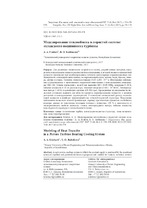| dc.contributor.author | Генбач, А. А. | ru |
| dc.contributor.author | Байбекова, В. О. | ru |
| dc.coverage.spatial | Минск | ru |
| dc.date.accessioned | 2017-11-23T07:12:30Z | |
| dc.date.available | 2017-11-23T07:12:30Z | |
| dc.date.issued | 2017 | |
| dc.identifier.citation | Генбач, А. А. Моделирование теплообмена в пористой системе охлаждения подшипника турбины = Modeling of Heat Transfer in a Porous Turbine Bearing Cooling System / А. А. Генбач, В. О. Байбекова // Энергетика. Известия высших учебных заведений и энергетических объединений СНГ. – 2017. – № 6. – С. 558-570. | ru |
| dc.identifier.uri | https://rep.bntu.by/handle/data/34885 | |
| dc.description.abstract | Для различных технических устройств и систем, разработанных авторами, предложена и исследована новая пористая система охлаждения, в которой подвод охлаждающей жидкости производят при комбинированном действии капиллярных и гравитационных сил. Поверхность охлаждения выполнялась из нержавеющей стали, латуни, меди, бронзы, никеля, алунда и стекла. Толщина стенки составляла (0,05–2,00) ∙ 10⁻³м. Визуальные наблюдения осуществлялись с применением скоростной киносъемки с использованием кинокамеры СКС-1М. Опыты проводили с водой при давлении 0,01–10,00 МПа, недогреве 0–20 К, избытке жидкости 1–14 от расхода пара, тепловой нагрузке (1–60) ∙ 10^4 Вт/м², температурном напоре 1–60 К и ориентации системы ±(0–90) град. Проведенные исследования на модельной установке выявили две области процесса парообразования жидкости и влияние режимных и конструктивных характеристик. Установлены оптимальный расход охлаждающей жидкости и наиболее эффективный вид сетчатой пористой структуры. Визуальные наблюдения позволили описать физическую картину протекающих процессов и обобщить опытные данные по отводимым тепловым потокам с точностью ±20 % в зависимости от
теплофизических свойств жидкости, стенки, температурного напора, избытка жидкости, вида пористой структуры и теплообменной стенки. | ru |
| dc.language.iso | ru | ru |
| dc.publisher | БНТУ | ru |
| dc.subject | Bearings of turbines | en |
| dc.subject | Capillary-porous Structure | en |
| dc.subject | Condensing zone | en |
| dc.subject | Vaporization zone | en |
| dc.subject | Подшипники турбин | ru |
| dc.subject | Капиллярно-пористая структура | ru |
| dc.subject | Зоны конденсации | ru |
| dc.subject | Зоны парообразования | ru |
| dc.title | Моделирование теплообмена в пористой системе охлаждения подшипника турбины | ru |
| dc.title.alternative | Modeling of Heat Transfer in a Porous Turbine Bearing Cooling System | en |
| dc.type | Article | ru |
| dc.relation.journal | Известия высших учебных заведений и энергетических объединений СНГ. Энергетика | ru |
| dc.identifier.doi | 10.21122/1029-7448-2017-60-6-558-570 | |
| local.description.annotation | A new porous cooling system in which the coolant supply is produced by the combined action of capillary and gravitational forces is proposed and studied for various technical devices and systems developed by the authors. The cooling surface is made of stainless steel, brass, copper, bronze, nickel, glass and alundum. The wall thickness is (0.05–2.00) ∙ 10⁻³m. Visual observations were carried out by using high-speed camera filming with the use of SCS-1M. Experiments were carried out with water at pressures ranging between 0.01–10.00 MPa, underheating to 0–20 K, excess liquid of 1–14 of steam flow, thermal load of (1–60) ∙ 10^4 W/m², temperature pressure of 1–60 K and the system orientation of ±(0–90) degrees. Studies carried out on a model plant has identified two areas of the process of vaporization of the liquid and an influence of operating and design characteristics. The optimal coolant flow and the most effective form of reticulated porous structure are identified. Visual observations have made it possible to describe the physical picture of the processes and to generalize experimental data on the removed heat flows with an accuracy of ±20 % depending on the thermophysical properties of the fluid, wall, temperature difference, excess fluid, porous structures and heat exchange interface. | en |

